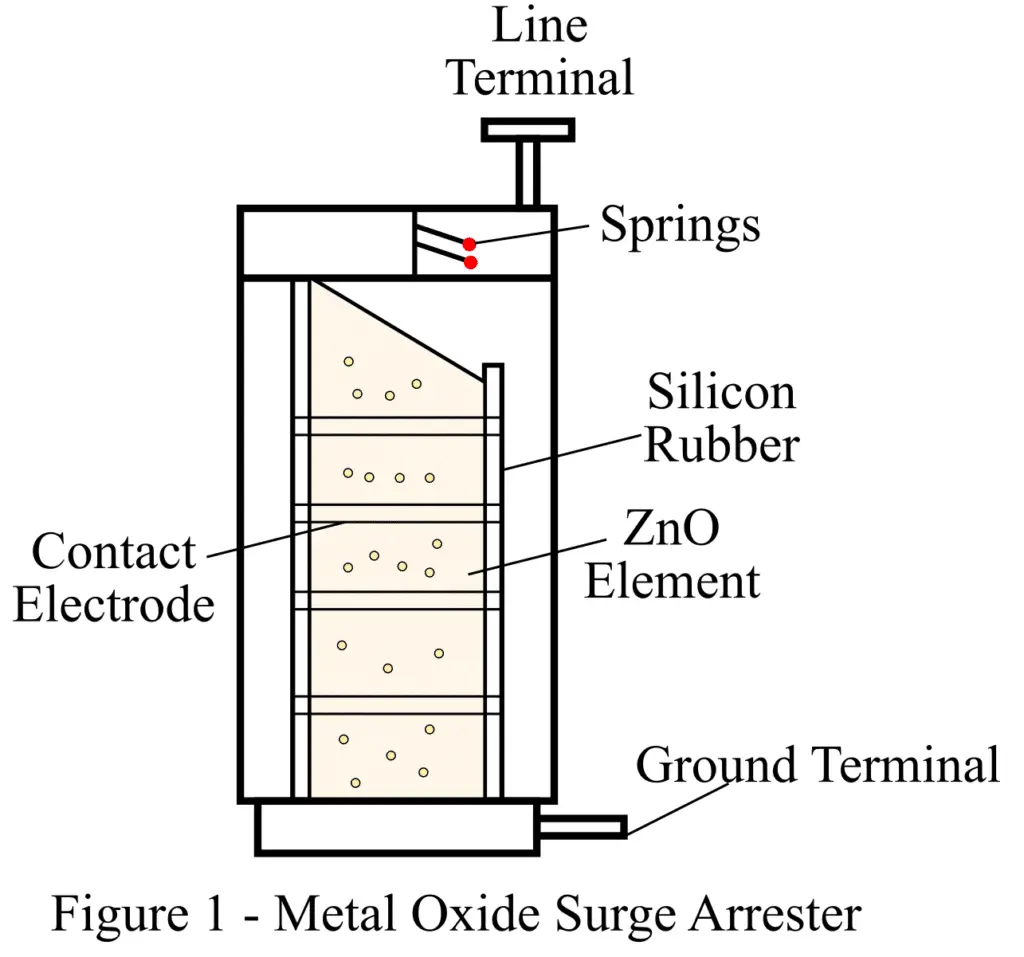In this article, we will discuss the metal oxide surge arrester. But before let us first know a bit about surge arresters and their importance in electrical systems.
What is a Surge Arrester?
The surge arrester, also called lightning arrester, is a surge protection device used in electrical systems to limit the over-voltages and overcurrents in the power system to improve the system protection level.
Mainly, surge arresters provide protection against temporary overvoltages, switching impulses, voltage surges, and lightning surges.
Several types of surge arresters have been designed, but to meet the protection demand for highly non-uniform V-I characteristics, the metal oxide surge arresters are designed to protect substation equipment.
Now, let us discuss the construction and working of the metal oxide surge arrester in detail.
Metal Oxide Surge Arrester
The type of surge arrester in which a zinc oxide semiconductor is utilized as a resistor material is known as a metal oxide surge arrester. It is also called a ZnO diverter.
The major advantage of the metal oxide surge arrester is that it protects the system from all types of DC and AC over-voltages. Therefore, it is used in electrical systems for protection from over-voltages of all voltage levels.
Construction and Working of Metal Oxide Surge Arrester
As mentioned above that the metal oxide surge arrester is made up of ZnO or zinc oxide semiconductor. ZnO is an N-type semiconductor material. ZnO is a pulverized and finely-grained material. With ZnO, several other insulating oxide materials like Bi2O3, Sb2O3, CoO, MnO2, etc. are also mixed in the form of fine powder. All these powders are treated with some processes and the final mixture is obtained as a dry powder.
This dry powder is then compressed in a block of disc shape. The disc-shaped blocks are sintered to obtain a dense poly-crystalline ceramic. Also, a conducting compound is used to coat the metal oxide disc to protect the disc from environmental impacts. This conducting compound coating also provides proper contact and uniform current distribution. A porcelain housing filled with nitrogen gas or SF6 gas is then used to enclose the disc. The construction of the metal oxide surge arrester is shown in figure-1.

In order to keep the disc in a fixed position, silicon rubber is used. It also assists in the transfer of heat from the disc to the porcelain housing. Springs are used for holding the disc under a certain pressure. The series spark gaps are eliminated by the ZnO element in the arrester.
There is a voltage drop in the metal oxide surge arrester that takes place at the grain boundaries. This potential barrier at the boundary of each grain of the ZnO element controls the flow of current from one grain to the next.
When there is a normal voltage, the potential barrier at the boundaries of grains of ZnO does not allow the current to flow through it. But, when an over-voltage occurs, the potential barrier collapse, and a sharp surge takes place. As a result, the current starts flowing and the surge is diverted to the earth.
Once, the surge collapse, the voltage across the ZnO diverters reduces and thus the current to a negligible value, ideally zero.
In this way, a metal oxide surge arrester protects the power system from over-voltage surges.
Now, let us know the major advantages of the metal oxide surge arrester.
Advantages of Metal Oxide Surge Arrester
The following are the major advantages of the metal oxide surge arrester:
- The need for a voltage grading scheme in the power system can be eliminated by using a metal oxide surge arrester.
- Metal oxide surge arrester is capable of absorbing high energy.
- Metal oxide surge arrester eliminates the risk of spark over.
- Metal oxide surge arrester eliminates the risk of shock to the system if gaps break down.
- Metal oxide surge arrester has a very low leakage current under normal operating conditions.
- Metal oxide surge arrester provides economic insulation coordination.
- Metal oxide surge arrester gives high stability after a long discharge.
Hence, this is all about the metal oxide surge arrester, its construction, working, and advantages.